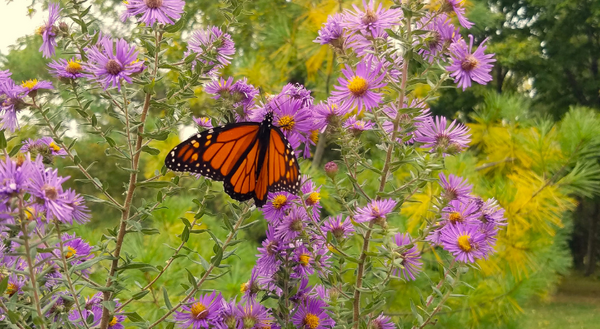
Migratory species across North America are on the move as the fall season progresses toward winter. Right now is the ideal time to observe bird migration, with many uncommonly observed species moving through our area on their way to the tropics. I’ve always marveled at the sheer distance some of these species travel.
It's hard to understand how the risks involved in such great distances add up to be worth it for the perpetuation of their numbers. I find it fascinating to think about how this behavior developed across the evolutionary timescale as I observe this annual migration each year.
Monarchs on the Move
One migratory species that has captivated the public in recent times is the monarch butterfly (Danaus plexippus). Some of this captivation is tied to the monarch’s declining populations across North America, which is currently at risk, but it's also the incredible migration distance (up to 2,500 miles) that draws attention.
However, there is some confusion on how the monarch lifecycle and migration function, which has led to quite a few questions from the public over recent weeks as monarchs have begun their annual move south.
It's been hard to find monarchs in Central Illinois this week, although I was seeing them as recently as early last week. Most folks don’t realize that the monarchs we see leave central Illinois in the fall are not the same individuals that arrived in the spring. Over the course of summer, monarchs have up to 3 generations of adults in our area. It’s the final generation of the year that migrates south to overwinter.
Throughout the summer, monarchs typically have a 4-6 week lifespan. However, the final generation for the year has a much longer life, spanning many months in their overwintering location. This generation also begins the spring migration north but never makes it as far as Illinois. They will lay eggs along the way that hatch into the first generation of the year that reaches us.
Monarchs in our area and all others east of the Rocky Mountains migrate to Mexico to overwinter. The one exception is some populations of non-migratory monarchs in Florida, which experience a warm enough climate year-round that there is no need to move further south. West of the Rockies, monarch populations overwinter in coastal California, or some make the trip south to Mexico.
Concerns About Late Caterpillars
As cooler nights have set in over recent weeks, I’ve received questions from concerned monarch spotters wondering if the individuals they are observing in their yards and gardens will make it south before succumbing to the cold. Many folks simply want to know what they can do to help, and there really isn’t a whole lot you can do at this point in the season. It's best to let nature take its course for these individuals.
Some folks in southern Illinois have reached out this week as they are still finding caterpillars and wondering if it's best to rear them indoors for protection from the cold. My answer was similar for them, that it's best to allow nature to take its course.
In this case, I worry that bringing monarchs indoors at this point in the season may disrupt their migration behavior. Recent research has shown that artificially-reared monarchs have a reduced ability to migrate. So, in my opinion, it is best to leave them in place, even if you are finding caterpillars on milkweed plants late in the season.
How You Can Help Monarchs
If you are interested in supporting migrating monarchs, the best thing you can do is add fall-blooming plants to your garden. The annual migration requires large amounts of energy for each butterfly making the long journey, and the nectar in your garden can help fuel the trek.
Right now, I have multiple species of native asters and a few goldenrods still in full bloom. Aromatic aster (Symphyotrichum oblongifolium) has just started blooming and will continue its display until killing frosts arrive much later in the season. Although it may be too late for migrating monarchs, it can be a valuable food source for other pollinators that are still active.
Even non-native species can be of benefit since they offer nectar. Numerous sedums (Sedum spp.) are blooming now and have been for weeks. These beautiful succulents provide ample blooms in fall, attracting various butterfly species.
Mexican sunflower (Tithonia rotundifolia) is a non-native annual that is highly attractive to monarchs and blooms late into the season. This member of the daisy plants develops into a large bushy plant with tons of blooms from mid-summer until frost. With tons of blooms come tons of seeds, so beware that this annual can readily self-seed.
Take a look around your garden right now to see what’s in bloom (or not in bloom), and consider what you might be able to add next year. Fall bloomers certainly benefit the butterflies but also help your garden space end the season with a colorful bang!
References
Freedman, MG and Kronforst, MR. 2023. Migration genetics take flight: genetic and genomic insights into monarch butterfly migration. Insect Science 59:101079.
Oberhauser, KS. 2019. Captivity concerns for monarch butterflies. Nature 573, 501-502.
Tenger-Trolander et al. Contemporary loss of migration in monarch butterflies. Proceedings of the National Academy of Sciences 116(29), 14671-14676.
Main Photo Caption: New England aster can be an important nectar source for migrating monarchs this time of year. Consider adding asters and other fall-blooming perennials in support of monarch migration. Photo by Ryan Pankau.